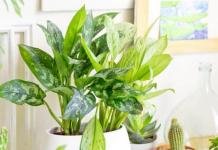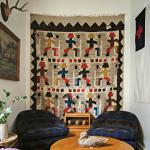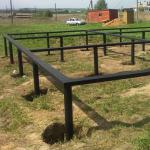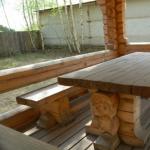The technique of creating paintings from pieces of fabric is called “kinusaiga”. This type of needlework appeared not so long ago, but has already become very popular. This unusual creative technique came to us from Japan and is divided into several subtypes: one of them is patchwork, and the second is sewing from patches, or quilting.
The difference lies in the specifics of creation, and the common feature is the material (multi-colored pieces of fabric).
Original canvases made from pieces of material will become a wonderful bright accent in the design of any room.
DIY fabric panel, photo
This educational article offers photos with ideas and master classes on creating handmade patchwork paintings and panels from fabric scraps using patterns downloaded from the Internet and sketches and drawings created by yourself.
 DIY fabric paintings, photos
DIY fabric paintings, photos Patchwork
The technique with the unusual name “patchwork” is unique; its peculiarity is that when creating decorative cloths from shreds, a needle is not used - just like threads. The main advantage of this technique is its simplicity of execution.
Thanks to patchwork, it is possible to create entire decorative masterpieces without much difficulty, even without any experience in needlework. This creative technology is ideal for beginner needlewomen.
 Paintings from scraps, photos
Paintings from scraps, photos Paintings from pieces of material are worth making for several reasons:
- they are great for decorating rooms whose interior is decorated in Provencal or country style;
- can be used to decorate any kitchen;
- are an excellent gift for any holiday and, above all, housewarming;
- to create them you need accessible materials;
- the work of producing decorative canvases takes a minimum of time;
- have a volumetric effect.

Before you begin the creative process, you should prepare the following tools and supplies:
- foam plastic tape measuring 2-2.5 cm (pieces of foam plastic that are used to package household appliances are suitable);
- pieces of fabric that differ in color, shape and size (it is recommended to use thin material - it is easier to make small parts from it, it is more difficult to work with denim scraps);
- office glue (do not use super glue, otherwise the foam will melt);
- paper cutting knife;
- small scissors;
- buttons;
- a tool designed for steaming seams (can be bought in stores that sell sewing supplies) or a manicure file, but it is more convenient to work with a steamer;
- printout of the diagram;
- carbon paper or marker.

 DIY paintings from scraps of fabric, photo
DIY paintings from scraps of fabric, photo Step-by-step instruction
Using step-by-step instructions and MK, you can create an unusual decorative fabric in a short time and sew a real beautiful picture from scraps of fabric.
If you don’t have a printer, instead of a ready-made drawing, you can make the image yourself. It is most convenient to draw the outlines of the picture in the cells. The pattern is transferred to the foam using carbon paper or drawn with a felt-tip pen. The canvas must be framed: the creative process begins with the manufacture of this particular part.

The foam blank can be of a square or rectangular configuration, depending on the specifics of the pattern. On each side of the foam base, draw a margin, making indentations of a couple of centimeters or a little more - this is the width of the frame.

On a note! To make it easier to transfer the pattern onto the foam blank, secure it with buttons.
Now it’s time to work with the knife. Using a cutting tool, make indentations of about 0.5 cm. If the grooves are deeper, the base will fall apart.

After this, you can take up the fabric. It is preferable to use knitted cuts - such fabric has the property of stretching and does not slip out of the grooves. It is worth first deciding on the placement of the flaps.

Apply glue to one area of the image using a brush.
Apply a flap of the appropriate size to this area.
Using a manicure file or a ripper, insert the edges of the material into the slits, and trim off the excess on the surface with scissors.

First of all, the frame is made using patchwork technique. The hanging edges of the fabric are folded over to the back and attached to the foam base with buttons or a stapler (try to pull the fabric tighter).
Having secured the canvas, they begin to create a drawing.

A hook or loop is attached to the back of the decorative canvas, thanks to which the picture is placed on the wall. Considering that polystyrene foam is a lightweight material, it can be fixed to the wall with mastic, which is used to fix tiles.
Using patchwork technology, individual images and entire modular compositions are created. To create picture modules, material with a large pattern is used, cutting it into separate fragments.

Recommendation: For beginning needlewomen, it is better to refrain from creating complex drawings in the first stages. Until you gain experience, it is better to practice on simple patterns without miniature elements, and the lines should be mostly straight. Once you gain experience, you can try your hand at creating more complex and intricate compositions.
The handmade Kinusaiga technique makes it possible to create simple, but at the same time nice and original decorative canvases and paintings.
 Fabric paintings, photos
Fabric paintings, photos Quilt - sewing from scraps
Another direction in needlework that allows you to make unusual paintings is called “quilt”, or sewing from scraps. Decorative canvases created using this creative technique make the interior warmer and more comfortable.
 Patchwork paintings
Patchwork paintings The principle of making decorative elements using the quilt technique is to stitch together several layers of fabric (by hand or by machine). This technique is used to create three-dimensional three-dimensional images with relief.
The effect of three-dimensional drawings is reproduced on decorative canvases.

The concept of “quilting” is borrowed from a foreign language and translated into Russian means “sewing from scraps.” This technology has been used in handicrafts for a long time. Decorative items created using this technique were found in village houses back in the last century. Surely many people understand how grandmothers made bedspreads, decorative pillows and chair covers from multi-colored scraps.

Such items are still relevant in our time, especially in Provencal-style interiors. Such decorative elements are also appropriate in a country-style setting. Such interiors are associated with rural life.
Today, such products serve primarily a decorative role, but previously they were also assigned a practical purpose.
A little later, using the technique of sewing from pieces of fabric, needlewomen began to make decorative canvases. Pictures made from small pieces of fabric look very unusual, and skillfully made items become unusual highlights in interiors.
A painting created using the quilt technique can depict an abstract drawing or a specific subject composition. Craftsmen make panels of fabulous beauty from pieces of fabric that attract attention with a riot of colors.
 Do-it-yourself volumetric fabric paintings
Do-it-yourself volumetric fabric paintings Differences between layers in quilting
The first layer is a lining, mainly made of cotton material.
The second layer is made from batting; it can also be padding polyester. Due to this layer, the picture acquires volume.
The front layer is a decorative finish combining embroidered patterns and appliqués.
The layers must be stitched (the seams are made in the form of stitches).

Floral panels for walls
Lovers of handmade items use a variety of materials to make them. Scraps of fabric can be found in any home.To make a beautiful and at the same time original painting with floral patterns, trimmings of any size, even very small ones, will be useful. Thrifty housewives usually do not throw away scraps, hoping to someday use them in business. The Japanese technique Kinusaiga provides such an opportunity.

To create a bright panel with floral patterns you will need about a couple of hours and the following materials:
- printout or hand-drawn diagram;
- scraps of fabric of different colors (the brighter the better);
- cardboard stencils - for creating leaves;
- scissors;
- office glue;
- beads;
- needle, thimble and thread.

First of all, rounded details differing in size are drawn on pieces of fabric using a stencil. A pyramid is made from round fragments. The assembly is carried out from the largest element (it is located at the bottom) to the smallest. The pyramid of parts is secured with a thread, and a bead is placed in the middle of the flower.

To make the edges of the flower wavy, lightly burn them with a candle. After this, cut out thin grass of varying heights from green material and attach it to the base by making a machine seam.
The painting is fixed to a frame base or stretched onto a frame, after which flowers are sewn to the canvas. Miniature elements are glued to the canvas.
The original panel can be placed on the wall in the kitchen, in the hallway, in the nursery, or as a gift to friends.

Recommendation! The frame can be replaced with a small hoop; these can be purchased at a store that sells craft supplies. The hoop allows you to stretch the material evenly and tightly, thanks to which the canvas looks neat.
Using hoops of different sizes, you can make an interesting floral-themed composition.

Paintings with floral motifs are placed on the same wall at different heights in close proximity to each other. Such decorative elements on the walls give the atmosphere a real homely feel.
Tulips, delicate roses, lilies - floral motifs are the ideal decoration.
Decorative canvases made from scraps on a New Year's theme
Preparing for the New Year holidays is both a hassle and a pleasure at the same time. Not everyone can afford to buy expensive gifts. In such a situation, you can make gifts with your own hands. One of the interesting options is decorative canvases made from scraps on a New Year’s theme. Even novice needlewomen can make such a present.

The atmosphere of the winter holidays is created from small details symbolizing the New Year, so a handmade picture made from scraps of fabric on a New Year's theme will fit perfectly into the decor.
On the New Year's decorative canvas you should depict the symbols of this beloved holiday: a decorated Christmas tree, Santa Claus, a sleigh with a reindeer team, a bright bag in which gifts are visible.

You will need scraps of material and leftover leather (only thin ones). Stock up on white, gold, light blue, emerald and red scraps. For the face of Santa Claus, you will also need pink or beige trimmings.
Cover the cardboard with chintz fabric in white or pale blue to create an imitation of snow.

After this, animals, a Christmas tree, Grandfather Frost and his beautiful granddaughter are made from cardboard of the same thickness - the plot may vary.
To give Santa Claus's beard a natural look, cut the material into fringe. It is best to make a sled from silver fabric. The Christmas tree is created from fabric in green shades.
Paintings from scraps of fabric are easy to create; even a child can master this technique.
Having prepared all the fragments, start gluing them together. A homemade painting made from scraps of fabric on a New Year's theme will delight both the creator himself and those to whom it will be presented.
New Year's motifs in wall decorations will help create the atmosphere of the winter holidays. Paintings made from colored scraps with New Year's characters give a festive mood and perform a decorative function.

The technique for creating decorative canvases from multi-colored fabric scraps is quite simple. It’s not difficult to find materials for making such masterpieces; you probably have scraps of fabric in your home. Such a gift, although cheap, is very original and no less attractive than expensive paintings sold in stores.
Video
There were times when paintings made with paints and brushes were in incredible demand. However, now they are in much less demand. They are competing with paintings made from scraps of fabric. Even those who have never been familiar with this technique before can make such a masterpiece with their own hands. The main thing is to carefully study the material presented below.
A few words about history
The technology, the features of which will be presented below, appeared relatively recently. But it quickly gained popularity. The Japanese invented it and called it kinusaiga. This creative technique involves working with scraps of fabric and allows you to create original crafts from what is often thrown into the trash. It is also worth noting that it includes several subspecies. The first is called patchwork, and the second is quilting or, in simpler terms, sewing from patches. The main difference is in the principle of operation or the specifics of creation. What is common is the material - various types of scraps or remnants of fabric. In any case, the creative process allows you not only to have an interesting time, but also to create a very beautiful and original picture from scraps of fabric with your own hands. If the needlewoman has imagination and proper execution, she will be able to complete a craft that will decorate any room, become a wonderful accent and create a cozy and comfortable environment.
Reasons for the popularity of the technique

Scientists have long come to the conclusion that a person needs to engage in creative work. Otherwise, coping with the hustle and bustle of everyday work can be so difficult that depression begins or various ailments and illnesses appear due to nervousness. Professional needlewomen do not insist, but they advise craftswomen to at least try to make a picture from scraps of fabric. This process is really exciting! In addition, the finished product can decorate absolutely any kitchen. Or a room decorated in country or Provencal style. You can also give a painting made by yourself to relatives, close friends, acquaintances for a birthday or other holiday. And for a housewarming such an original gift will be especially useful! And all this despite the fact that the work will require available materials, and the creative process will not take much time.
Patchwork technique
Experienced needlewomen, talking about the features of this technique, note that it is unique, that is, one of a kind. And all because neither a sewing needle nor thread is used during the work. It is believed that the main advantage of patchwork is its unpretentiousness, simplicity, and uncomplicated execution. However, regardless of this, paintings made by hand from scraps of fabric look interesting and original. It is also noteworthy that patchwork is ideal for novice craftsmen, because it allows those who have no experience in needlework to create spectacular crafts.
Tools and materials for patchwork

To bring your idea to life, first of all you need to prepare various scraps and leftover fabric of various sizes, colors and textures. Professional craftswomen recommend using thinner material. Because working with it is much easier and more convenient. In addition, you should prepare:
- stationery knife for cutting paper;
- wooden ruler;
- comfortable scissors;
- black marker;
- buttons.
You also need to purchase a seam ripper - a tool for ripping seams - from a craft store. If you can’t find one, you can use a regular nail file. The basis for creating a picture from scraps of fabric using the patchwork technique is a rectangular or square piece of foam plastic. Moreover, you can take the one that is used to protect household appliances from damage. Experienced needlewomen say that if you have to cut the foam yourself, you should go to a room that does not have a carpet or rug. Otherwise, subsequent cleaning will turn into a real nightmare.
Since we will not be sewing the craft, glue will be required. However, it is important to immediately note that you should choose PVA glue or other stationery glue, because different types of superglue can melt the foam. To work, you also need to print an image of a picture or prepare a drawing, which we will use as a template for creativity.
Features of choosing a pattern
If you look at photos of paintings made from scraps of fabric, you will want to make the most interesting and original craft with your own hands. However, experienced masters do not recommend that beginners immediately take on the difficult option. The Kinusaiga technique allows you to create very simple, but at the same time attractive paintings. Therefore, at first it is better to choose a simple image. If the reader wants to make a unique work, he can draw a picture. But in this case, you should also not add miniature elements, and it is better to make the lines as straight as possible. Only after mastering the technology and making several paintings can you begin to create large and complex images, as well as modular ones. In addition, it is important to note that if the reader cannot choose the optimal design option, professional craftswomen advise looking at the pictures presented in children's coloring books. These images are simplified as much as possible and adapted for children. Therefore, it will be easy for novice craftsmen to turn them into a patchwork picture.

How to make paintings using patchwork technique
When everything you need is ready to hand, we begin to make our own paintings from scraps of fabric.
- First of all, we take the prepared piece of polystyrene foam and, stepping back two centimeters from each edge, use a ruler and marker to draw a frame.
- We press through the resulting lines with a stationery knife. We don’t lower it too deep; a half-centimeter “groove” is enough.
- Then we take a drawing or picture. We place it in the center of the foam and attach it with buttons at the four corners.
- Using a knife, very carefully make indentations along the contour of the image.
- At this point, the preparatory stage is completed, and we proceed directly to the instructions on how to make paintings on foam plastic from scraps of fabric.
- In fact, this process does not involve difficult actions. We take the prepared material and a steamer or nail file.
- We determine the area of the picture that we will decorate and apply a little glue to it.
- Cut or select a flap of the desired size.
- We apply the image to the desired area and begin to carefully push the edges of the flap into the “grooves”.
- If there is excess fabric, it should be carefully trimmed with scissors and tucked in. Experienced needlewomen recommend using slightly curved nail scissors for these purposes.
This, in fact, is the whole essence of the technique of making paintings from scraps of fabric. Further work involves filling all areas with fabric as described earlier. Then you need to frame the paintings. To do this, cut out the entire frame or individual pieces. On the front side we tuck the edges into the “grooves”, and on the sides we bend them slightly and secure them with buttons. Finally, we add a crochet hook to the finished craft so that it can be hung on the wall.
Quilting technique

The next type of art of creating surprisingly beautiful patchwork paintings involves stitching together various materials either by machine or by hand. Moreover, it is important to note that this technique allows you to create three-dimensional or three-dimensional paintings from fabric with your own hands. Experienced craftsmen believe that this type of needlework is difficult for beginners. However, if you wish, you can still try to make a simple and original picture. In addition, many craftswomen can turn to their grandmother for advice and help. After all, decorative products made using the technology being studied were very popular in the last century. Perhaps someone even still has a bedspread made from scraps, or colorful pillows. As we mentioned earlier, such crafts are still popular today. They are especially often used to decorate interiors in Provencal or country style. Designers suggest adding patchwork paintings to the interior in a minimalist style to create a warmer and more homely environment.
Multi-layering using quilting technique
Professional needlewomen, explaining the principle of creating a picture from scraps of fabric to beginners, note that layers are of great importance in the technique, the sequence of which is important to observe. Therefore, this article should study this feature of the technology in detail. Cotton material acts as the base or first layer. It serves as a lining. The second layer is necessary to create volume, so what follows is a padding polyester or batting layer. The third is the canvas. You can purchase it at any craft store. The fourth and final layer is also called the face layer. It is essentially a decorative finish with stripes, appliqués, various patterns and more. It is extremely important to note that needlewomen must stitch all the layers so that the finished picture from scraps of fabric for children or adults turns out to be seamless. At the same time, if they work manually, they make a seam in the form of stitches.

Quilting Tools and Materials
The attentive reader has already noticed that this technology involves working with a needle and thread or a sewing machine. Therefore, the first thing we do is prepare these tools. We also need a picture or drawing on which we will build our craft. In addition, you need scissors, an iron or steam generator, several sheets of cardboard, carbon paper, many colorful scraps and, if necessary, a thimble. Experienced craftswomen recommend planning your work in advance. For this you need a simple pencil. They should draw lines on the prepared image, thus marking the seam lines.
How to make paintings using quilting technique
Having prepared everything you need, we proceed to the instructions on how to make a picture from scraps of fabric.
- First of all, we transfer our drawing onto a prepared sheet of cardboard. We do this with a simple pencil and carbon paper.
- Then we carefully outline the contours of all the fragments and mark the seam lines.
- We number all the details.
- From the prepared scraps, we select those that most closely match the color scheme of the intended painting. We are especially carefully looking for a material with which we can create transitions from one shade to another.
- We lay out the prepared flaps as they will be located in the plan. This is necessary in order to finally make sure that the choice is correct.
- We straighten all the approved flaps, and then thoroughly steam them.
- Cut out all numbered pieces from cardboard.
- We use them as templates to cut out fabric parts.
- Additionally, we prepare a cotton base (you can use an old sheet), a thick lining and canvas. The dimensions of the three layers should be the same.
- Next we work with the details that serve as the background. We fold the adjacent ones with the right sides facing each other and carefully sew them by hand or using a machine.
- Trim off the excess, turn it over onto your face and steam thoroughly. The last action is necessary so that the flaps do not move and the picture does not turn out crooked.
- Having collected the background of the picture, we “revive” it with the help of the remaining fragments.
- Then we sew the lining to the base, and then the canvas with the applique.
- We decorate the panel with finishing tape.
- And once again we thoroughly steam all the work.

Master class for beginners and children
It was said earlier that at first it is better to choose simpler paintings from scraps of fabric. Photos of professional work, of course, attract attention. However, to perform them you must have at least basic skills in working with the Kinusaiga technique. As you know, mastery comes with experience, so first you should practice on the most basic sketches in the style of children's drawings. At the same time, patchwork, as a type of studied technique, is best suited for beginners and children. Below is a video instruction prepared by a professional master. Using it you will be able to trace the entire creative process and, if desired, following the step-by-step recommendations of the master class, repeat the picture.

Now you should understand the specifics of creating original paintings from fabric with your own hands. Photos of finished works and a detailed description will help the reader determine the most suitable and interesting technique, and then realize any of his ideas. Experienced needlewomen note that the creative process is so addictive that learning will go quickly and bring a lot of pleasant emotions. After some time, experience is gained, and even then the former beginner will be able to make real masterpieces.
Paintings made from scraps of fabric are a relatively new type of needlework called kinusaiga. The word is of Japanese origin, as this is where this creativity originated.
Kinusaiga is divided into several directions: patchwork, patchwork (quilting, quilting). What unites them is the material - flaps, but what distinguishes them is the technique of execution.




A picture made from scraps with the addition of knitting threads

The picture is sewn using one of the patchwork techniques - quilt
In this topic, the reader will learn how to make paintings from scraps of fabric with their own hands, the diagrams of which can be downloaded and printed from the Internet.

Meet patchwork
The uniqueness of the patchwork technique is that paintings from scraps of fabric are created without the use of a needle and thread. And the advantage of patchwork is its relative simplicity of execution, so even a novice master can create real masterpieces. Paintings from scraps of fabric:

Panel of flowers using the Kinusaiga technique
- are a worthy decoration for an interior in country or Provence style.
- will be appropriate in any kitchen.
- They will be a good gift for relatives or friends on the occasion of a housewarming or other celebration.
- do not require the purchase of expensive materials (everything you need can be found in any home).
- performed quickly (3-4 hours).
- have a 3D effect.

Before starting work, you need to prepare materials and tools so that they are at hand at all times.
- A sheet of polystyrene foam with a density of 25, 2-2.5 cm thick. You can use pieces that are used to package equipment at manufacturing plants.
- All kinds of colorful rags of different sizes. It is desirable that the fabric is thin. Rough and dense material is not suitable for small parts.
- PVA glue (superglue is not suitable, it melts the foam).
- A scalpel and a stationery knife (you can use one or the other).
- Manicure scissors.
- A seam ripper, which can be purchased at any craft store. Some craftswomen use a nail file; This is also possible, but the first option is more convenient.
- Diagram printed on a sheet of paper.
- Felt pen or carbon paper.

The most necessary tools for creating a patchwork painting
Advice! When cutting foam plastic, and even during work, small white balls will inevitably crumble and create debris. Therefore, it is better to work in a room where there is no high-pile carpet, so that you can easily clean up the mess later.

Step-by-step execution of a painting from fabric scraps. Master Class
If you don’t have a printer, you can draw the picture yourself by hand or by cells. The drawing must be transferred to the foam using carbon paper or drawn with a marker. The picture must have a frame, so the work begins with this element.

The foam can be square or rectangular in shape - it all depends on the design itself. On each edge of the foam fragment you need to draw a margin of 2-4 cm - this is exactly the width of the frame.

To make it easier to transfer the design to the foam, we secure it with buttons
It's time to pick up a scalpel or a utility knife. Using any of these tools, grooves 0.5-1 cm deep are cut. Deeper cuts will lead to a break in the base, and this should not be allowed.

Now you need to take the fabric. It is best to work with knitted patches; they stretch well and do not pop out of the slits. It is recommended to distribute the flaps in advance: which one will go where.

Using a ripper or a nail file, insert the edges of the fabric into the slits, then cut off the remainder and hide it in foam until the end
- PVA glue is applied to the selected fragment of the design with a brush.
- A proportionate piece of fabric is applied to this place.
- Using a nail file or seam ripper, the edges of the flap are tucked into the slits.
- The edges of the fabric remaining on top are trimmed with nail scissors.

First, a frame is made using this technique. The free edges are folded over and secured to the foam with buttons or a stapler. Next, the entire drawing is completed.

A hook is attached to the back wall of the painting or a loop is sewn on, through which the hand-made masterpiece is hung on the wall. Since the foam is very light, it can be glued to the wall with tile mastic.
In the patchwork technique, both individual designs and modular compositions are performed. For picture blocks, use fabric with a large print, cutting it into pieces.

Advice! Pictures from scraps of fabric for beginners should not be complex and curvilinear. At first, it is recommended to choose simple images in which there are no small details and the lines are mostly straight. Over time, when experience comes, it will be possible to take on more complex compositions.

Nice simple painting using the kinusaiga technique
Quilt - patchwork sewing
Another type of needlework that is used to create original paintings that fill the interior with warmth and homeliness. The essence of the procedure is to sew together three or more layers of fabric (using a sewing machine or by hand), resulting in a three-dimensional relief pattern on the surface. The picture gives the impression of a 3D effect.
“Quilting” is a borrowed foreign word; this handicraft is simply called patchwork. This technique appeared a long time ago; it could be seen in the interiors of village houses of the last century. Our grandmothers, collecting all kinds of scraps of fabric, sewed multi-colored blankets, bedspreads, and pillows.

Similar products can still be found today. They are characteristic of country and Provence style interiors, identified with rural life. All these gizmos currently play more of a decorative role than necessities.
Somewhat later, using patchwork, craftsmen began to produce paintings, and some of them are made so skillfully that they amaze the imagination. A quilt can be a kind of abstraction or convey a specific plot.

How do layers differ from each other in quilting?
- The first layer is the lining, for which, as a rule, cotton scraps of fabric are used.
- To create the second layer, use batting or padding polyester. It is this layer that is necessary to add volume.
- The third layer (top) is decorative. It is combined with applique, collage, embroidery.
The layers must be quilted together with a seam.

Decorate the walls with panels with flowers
Handmade people use a variety of materials to create masterpieces. Shreds can be found in every apartment. To create an original decorative panel with floral motifs, even the smallest pieces of fabric are suitable, which a thrifty housewife does not throw away, but puts in a separate box.

To complete a flower panel, which will take no more than 2 hours, you need to prepare:
- a scheme that you can choose on the Internet or come up with yourself.
- multi-colored bright rags.
- cardboard templates - they are needed for cutting out petals.
- scissors.
- beads.
- glue.
- needle and thread.

Necessary tools for creating a masterpiece with your own hands
First, round blanks of different sizes are drawn on the flaps using a template. The cut out circles are collected in a pyramid, the large one is placed down and reaches the smallest one. They grab the stack of blanks with a thread, and secure a bead in the center of the flower.

To give the edges a waviness, the flower is lightly burned with a candle flame. Then thin blades of grass of different lengths are cut out of green fabric and assembled onto a base using machine stitching. The canvas is attached to any frame or stretched over a frame and flowers are sewn to it. The smallest parts are fixed to the main canvas with glue.
That's all, the wall panel is ready! You can hang it in the kitchen, nursery, hallway or give it to friends.

Advice! Instead of a frame, you can use a small wooden hoop. They are inexpensive and can be found at any craft store. The fabric is stretched tightly in the hoop, so the picture looks very neat. By purchasing hoops of different sizes, you can create an entire flower arrangement - several paintings are hung on one wall at different heights, but close to each other.

New Year's paintings from scraps of fabric for beginners
New Year's chores are very pleasant, but it is not always financially possible to give gifts to everyone you want. However, there is a way out - to make your own New Year’s picture from pieces of fabric.
A small New Year's picture in a hoop, made by yourself
You need to stock up on pieces of fabric and thin leather. Colors: red, white, blue, gold, green, and for the face of Santa Claus you will need pink scraps. Ordinary cardboard is covered with chintz. If the main background is snow, you should take a white or bluish fabric.

Next, figures of animals, Santa Claus, the Snow Maiden, and a Christmas tree are cut out of the same cardboard, depending on the intended plot. To make Santa Claus's beard look natural, the fabric for it needs to be cut into fringes. For sleds, fabric with a silver tint is best suited. The Christmas tree is assembled from several types of fabric with different shades of green.
The New Year's panel will lift your spirits and put you in a festive mood
The technique of making paintings from scraps is not complicated. There is no need to buy materials; they will definitely be found in any home. Despite the cheapness of the finished product, it will please the eye no less than a landscape or still life, which costs a lot of money.
Currently, the patchwork technique has become very popular - a type of needlework in which a whole product with a certain pattern is sewn from multi-colored scraps of fabric using the mosaic principle.
Patchwork (translated from English as “patch” + “work”) is a very interesting and labor-intensive technique. But the products obtained with its help cannot but rejoice.
Products in the patchwork style are always distinguished by individuality and elegance, and at the same time they are practical things. This technique has long and deservedly enjoyed enormous popularity both in Russia and in Europe. The patchwork technique is very popular in Japan. There is even a whole fashion trend - Japanese patchwork.
A very interesting option is patchwork painting. Anyone can create paintings in the patchwork style. Paintings using this technique can be used to decorate a child’s room or kitchen.
Set of tools for patchwork sewing
1. Various fabrics;
3. Special roller knife or scissors;
4. Pins and sewing needles;
5. Pencil or chalk (for drawing a design on fabric);
6. Cardboard, thick paper or soft plastic (for making templates);
7. Crochet hook;
8. Sewing machine.
In specialized stores you can also purchase ready-made patchwork kits, which, in addition to materials and tools, also include pattern diagrams.
The Curious World invites you to view a selection of stunning paintings using the patchwork technique.































